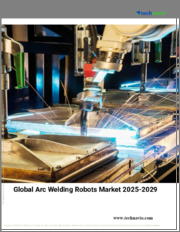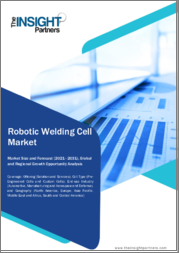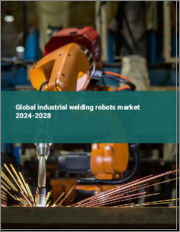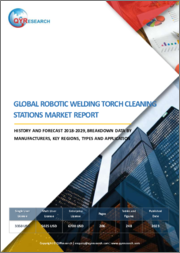
|
시장보고서
상품코드
1722681
로봇 용접 시장 보고서 : 유형, 페이로드, 최종사용자, 지역별(2025-2033년)Robotic Welding Market Report by Type, Payload, End User, and Region 2025-2033 |
||||||
세계 로봇 용접 시장 규모는 2024년 77억 달러에 달했습니다. 향후 IMARC Group은 시장이 2033년까지 143억 달러에 달하고, 2025-2033년 6.75%의 연평균 성장률(CAGR)을 보일 것으로 예측하고 있습니다.
자동 용접으로도 알려진 로봇 용접은 금속 재료를 가열, 혼합 및 냉각하는 기계화된 프로그래밍 가능한 장비를 사용하여 두 재료를 융합하는 프로세스입니다. 결함의 원인이 되는 인위적인 실수, 피로, 산만함을 줄이면서 용접의 무결성을 높이고 일관된 결과로 빠른 품질의 용접을 실현합니다. 로봇 용접은 보다 정확하고 정밀한 용접에 도움이 되므로 수작업 용접에 비해 스크랩과 폐기물이 적습니다. 또한, 적은 인력으로 다양한 용접 공정을 수행할 수 있기 때문에 생산에 인력을 추가할 필요가 없습니다. 그 결과, 로봇 용접은 전 세계 자동차, 전자, 항공우주, 방위, 건설, 광업 등의 분야에서 폭넓게 활용되고 있습니다.
로봇 용접 시장 동향 :
산업재해 감소, 주문 처리 속도 및 정확도 향상, 비용 절감으로 인한 가동 시간 증가로 인해 전 세계적으로 로봇 용접의 사용이 증가하고 있습니다. 이는 작업 공간의 효율적인 활용을 강화하고 최종 사용자 산업에서 공급망 성능을 향상시키기 위해 로봇 용접에 대한 수요 증가와 함께 시장을 주도하는 중요한 요인 중 하나입니다. 또한, 주요 시장 참여자들은 로봇 용접이 제공하는 기능과 이점을 개선하기 위해 연구 개발(R&D) 활동에 광범위하게 투자하고 있습니다. 또한, 로봇 용접은 클라우드 기반 운영 및 원격 모니터링과 같은 다양한 요구 사항을 충족하기 위해 사용자 정의가 진행되고 있으며, 인간 노동력과의 친화력을 높이기 위해 효과적인 물리적 체격을 갖추고 있는 것도 시장에 긍정적인 영향을 미치고 있습니다. 또한, 자동차 산업에서 저항 스폿 용접 및 아크 용접의 고생산성 응용 분야에서 로봇 용접의 채택이 증가하고 있으며, 이는 업계 투자자에게 유리한 성장 기회를 제공합니다. 이 외에도 로봇 용접은 재프로그래밍이 가능하기 때문에 하드 툴링을 최소화할 수 있습니다.
본 보고서에서 다룬 주요 질문
- 2024년 세계 로봇 용접 시장 규모는?
- 2025-2033년 로봇 용접 세계 시장 성장률 전망은?
- 코로나19가 세계 로봇 용접 시장에 미치는 영향은?
- 로봇 용접 세계 시장을 이끄는 주요 요인은?
- 로봇 용접 세계 시장에서의 유형별 분류는?
- 페이로드 기반 로봇 용접 세계 시장 분석은?
- 로봇 용접 세계 시장 내 최종 사용자별 시장 현황은?
- 로봇 용접 세계 시장에서 주요 지역은?
- 세계 로봇 용접 시장의 주요 기업은?
목차
제1장 서문
제2장 조사 범위와 조사 방법
- 조사 목적
- 이해관계자
- 데이터 소스
- 1차 정보
- 2차 정보
- 시장 추정
- 보텀업 접근
- 톱다운 접근
- 조사 방법
제3장 주요 요약
제4장 서론
- 개요
- 주요 업계 동향
제5장 세계의 로봇 용접 시장
- 시장 개요
- 시장 실적
- COVID-19의 영향
- 시장 예측
제6장 시장 분석 : 유형별
- 스팟 용접
- 아크 용접
- 기타
제7장 시장 분석 : 페이로드별
- 50kg 미만
- 50-150kg
- 150kg 이상
제8장 시장 분석 : 최종사용자별
- 자동차 및 운송
- 전기 및 전자 공학
- 금속 및 기계
- 기타
제9장 시장 분석 : 지역별
- 북미
- 미국
- 캐나다
- 아시아태평양
- 중국
- 일본
- 인도
- 한국
- 호주
- 인도네시아
- 기타
- 유럽
- 독일
- 프랑스
- 영국
- 이탈리아
- 스페인
- 러시아
- 기타
- 라틴아메리카
- 브라질
- 멕시코
- 기타
- 중동 및 아프리카
- 시장 내역 : 국가별
제10장 SWOT 분석
- 개요
- 강점
- 약점
- 기회
- 위협
제11장 밸류체인 분석
제12장 Porter의 Five Forces 분석
- 개요
- 바이어의 교섭력
- 공급 기업의 교섭력
- 경쟁 정도
- 신규 진출업체의 위협
- 대체품의 위협
제13장 가격 분석
제14장 경쟁 구도
- 시장 구조
- 주요 기업
- 주요 기업 개요
- ABB Ltd.
- Comau(Stellantis N.V.)
- DAIHEN Corporation
- FANUC Corporation
- Hyundai Robotics Co. Ltd.(Hyundai Heavy Industries Group)
- Kawasaki Heavy Industries Ltd.
- KUKA AG
- Nachi-Fujikoshi Corp.
- Panasonic Corporation
- Siasun Robot & Automation Co. Ltd.
- Yaskawa Electric Corporation
The global robotic welding market size reached USD 7.7 Billion in 2024. Looking forward, IMARC Group expects the market to reach USD 14.3 Billion by 2033, exhibiting a growth rate (CAGR) of 6.75% during 2025-2033.
Robotic welding, also known as automated welding, is a process of fusing two materials together using mechanized programmable instruments that heat, mix, and cool metal materials. It ensures that weld integrity is enhanced with consistent results for fast quality welds while reducing human errors, fatigue and distractions that may cause defects. As it helps in more accurate and precise welding, there are fewer scrap metals and wastes with robotic welding compared to manual welding. In addition, it performs different welding processes with less manpower and without the need for hiring additional staffing for production. As a result, it finds extensive applications in automotive, electronics, aerospace, defense, construction, and mining industries across the globe.
Robotic Welding Market Trends:
Due to reduced intensive labor injuries, improved order fulfilment speed and accuracy, and increased uptime with reduced costs, there is a rise in the utilization of robotic welding around the world. This, along with the growing demand for robotic welding to enhance the efficient use of working space and improve the supply chain performance in end-user industries, represents one of the key factors driving the market. Moreover, key market players are extensively investing in research and development (R&D) activities to improve the functions and benefits offered by robotic welding. This, coupled with the rising customization of robotic welding for several requirements, such as cloud-based operations and remote monitoring, along with effective physical stature for improved compatibility with the human workforce, is positively influencing the market. Additionally, the increasing employment of robotic welding in the automotive industry for resistance spot welding and arc welding in high production applications is offering lucrative growth opportunities to industry investors. Besides this, robotic welding requires minimal hard tooling as they are reprogrammable, which is projected to bolster the market growth.
Key Market Segmentation:
Breakup by Type:
Robotic Welding Market Report
- Spot Welding
- Arc Welding
- Others
Breakup by Payload:
- Less than 50 Kg
- 50-150 Kg
- More than 150 Kg
Breakup by End User:
- Automotive and Transportation
- Electrical and Electronics
- Metals and Machinery
- Others
Breakup by Region:
Robotic Welding Market Report
- North America
- United States
- Canada
- Asia-Pacific
- China
- Japan
- India
- South Korea
- Australia
- Indonesia
- Others
- Europe
- Germany
- France
- United Kingdom
- Italy
- Spain
- Russia
- Others
- Latin America
- Brazil
- Mexico
- Others
- Middle East and Africa
Competitive Landscape:
The competitive landscape of the industry has also been examined along with the profiles of the key players being ABB Ltd., Comau (Stellantis N.V.), DAIHEN Corporation, FANUC Corporation, Hyundai Robotics Co. Ltd. (Hyundai Heavy Industries Group), Kawasaki Heavy Industries Ltd., KUKA AG, Nachi-Fujikoshi Corp., Panasonic Corporation, Siasun Robot & Automation Co. Ltd. and Yaskawa Electric Corporation.
Key Questions Answered in This Report
- 1.What was the size of the global robotic welding market in 2024?
- 2.What is the expected growth rate of the global robotic welding market during 2025-2033?
- 3.What has been the impact of COVID-19 on the global robotic welding market?
- 4.What are the key factors driving the global robotic welding market?
- 5.What is the breakup of the global robotic welding market based on the type?
- 6.What is the breakup of the global robotic welding market based on the payload?
- 7.What is the breakup of the global robotic welding market based on the end user?
- 8.What are the key regions in the global robotic welding market?
- 9.Who are the key players/companies in the global robotic welding market?
Table of Contents
1 Preface
2 Scope and Methodology
- 2.1 Objectives of the Study
- 2.2 Stakeholders
- 2.3 Data Sources
- 2.3.1 Primary Sources
- 2.3.2 Secondary Sources
- 2.4 Market Estimation
- 2.4.1 Bottom-Up Approach
- 2.4.2 Top-Down Approach
- 2.5 Forecasting Methodology
3 Executive Summary
4 Introduction
- 4.1 Overview
- 4.2 Key Industry Trends
5 Global Robotic Welding Market
- 5.1 Market Overview
- 5.2 Market Performance
- 5.3 Impact of COVID-19
- 5.4 Market Forecast
6 Market Breakup by Type
- 6.1 Spot Welding
- 6.1.1 Market Trends
- 6.1.2 Market Forecast
- 6.2 Arc Welding
- 6.2.1 Market Trends
- 6.2.2 Market Forecast
- 6.3 Others
- 6.3.1 Market Trends
- 6.3.2 Market Forecast
7 Market Breakup by Payload
- 7.1 Less than 50 Kg
- 7.1.1 Market Trends
- 7.1.2 Market Forecast
- 7.2 50-150 Kg
- 7.2.1 Market Trends
- 7.2.2 Market Forecast
- 7.3 More than 150 Kg
- 7.3.1 Market Trends
- 7.3.2 Market Forecast
8 Market Breakup by End User
- 8.1 Automotive and Transportation
- 8.1.1 Market Trends
- 8.1.2 Market Forecast
- 8.2 Electrical and Electronics
- 8.2.1 Market Trends
- 8.2.2 Market Forecast
- 8.3 Metals and Machinery
- 8.3.1 Market Trends
- 8.3.2 Market Forecast
- 8.4 Others
- 8.4.1 Market Trends
- 8.4.2 Market Forecast
9 Market Breakup by Region
- 9.1 North America
- 9.1.1 United States
- 9.1.1.1 Market Trends
- 9.1.1.2 Market Forecast
- 9.1.2 Canada
- 9.1.2.1 Market Trends
- 9.1.2.2 Market Forecast
- 9.1.1 United States
- 9.2 Asia-Pacific
- 9.2.1 China
- 9.2.1.1 Market Trends
- 9.2.1.2 Market Forecast
- 9.2.2 Japan
- 9.2.2.1 Market Trends
- 9.2.2.2 Market Forecast
- 9.2.3 India
- 9.2.3.1 Market Trends
- 9.2.3.2 Market Forecast
- 9.2.4 South Korea
- 9.2.4.1 Market Trends
- 9.2.4.2 Market Forecast
- 9.2.5 Australia
- 9.2.5.1 Market Trends
- 9.2.5.2 Market Forecast
- 9.2.6 Indonesia
- 9.2.6.1 Market Trends
- 9.2.6.2 Market Forecast
- 9.2.7 Others
- 9.2.7.1 Market Trends
- 9.2.7.2 Market Forecast
- 9.2.1 China
- 9.3 Europe
- 9.3.1 Germany
- 9.3.1.1 Market Trends
- 9.3.1.2 Market Forecast
- 9.3.2 France
- 9.3.2.1 Market Trends
- 9.3.2.2 Market Forecast
- 9.3.3 United Kingdom
- 9.3.3.1 Market Trends
- 9.3.3.2 Market Forecast
- 9.3.4 Italy
- 9.3.4.1 Market Trends
- 9.3.4.2 Market Forecast
- 9.3.5 Spain
- 9.3.5.1 Market Trends
- 9.3.5.2 Market Forecast
- 9.3.6 Russia
- 9.3.6.1 Market Trends
- 9.3.6.2 Market Forecast
- 9.3.7 Others
- 9.3.7.1 Market Trends
- 9.3.7.2 Market Forecast
- 9.3.1 Germany
- 9.4 Latin America
- 9.4.1 Brazil
- 9.4.1.1 Market Trends
- 9.4.1.2 Market Forecast
- 9.4.2 Mexico
- 9.4.2.1 Market Trends
- 9.4.2.2 Market Forecast
- 9.4.3 Others
- 9.4.3.1 Market Trends
- 9.4.3.2 Market Forecast
- 9.4.1 Brazil
- 9.5 Middle East and Africa
- 9.5.1 Market Trends
- 9.5.2 Market Breakup by Country
- 9.5.3 Market Forecast
10 SWOT Analysis
- 10.1 Overview
- 10.2 Strengths
- 10.3 Weaknesses
- 10.4 Opportunities
- 10.5 Threats
11 Value Chain Analysis
12 Porters Five Forces Analysis
- 12.1 Overview
- 12.2 Bargaining Power of Buyers
- 12.3 Bargaining Power of Suppliers
- 12.4 Degree of Competition
- 12.5 Threat of New Entrants
- 12.6 Threat of Substitutes
13 Price Analysis
14 Competitive Landscape
- 14.1 Market Structure
- 14.2 Key Players
- 14.3 Profiles of Key Players
- 14.3.1 ABB Ltd.
- 14.3.1.1 Company Overview
- 14.3.1.2 Product Portfolio
- 14.3.1.3 Financials
- 14.3.1.4 SWOT Analysis
- 14.3.2 Comau (Stellantis N.V.)
- 14.3.2.1 Company Overview
- 14.3.2.2 Product Portfolio
- 14.3.3 DAIHEN Corporation
- 14.3.3.1 Company Overview
- 14.3.3.2 Product Portfolio
- 14.3.3.3 Financials
- 14.3.4 FANUC Corporation
- 14.3.4.1 Company Overview
- 14.3.4.2 Product Portfolio
- 14.3.4.3 Financials
- 14.3.4.4 SWOT Analysis
- 14.3.5 Hyundai Robotics Co. Ltd. (Hyundai Heavy Industries Group)
- 14.3.5.1 Company Overview
- 14.3.5.2 Product Portfolio
- 14.3.6 Kawasaki Heavy Industries Ltd.
- 14.3.6.1 Company Overview
- 14.3.6.2 Product Portfolio
- 14.3.6.3 Financials
- 14.3.6.4 SWOT Analysis
- 14.3.7 KUKA AG
- 14.3.7.1 Company Overview
- 14.3.7.2 Product Portfolio
- 14.3.7.3 Financials
- 14.3.7.4 SWOT Analysis
- 14.3.8 Nachi-Fujikoshi Corp.
- 14.3.8.1 Company Overview
- 14.3.8.2 Product Portfolio
- 14.3.8.3 Financials
- 14.3.8.4 SWOT Analysis
- 14.3.9 Panasonic Corporation
- 14.3.9.1 Company Overview
- 14.3.9.2 Product Portfolio
- 14.3.9.3 Financials
- 14.3.9.4 SWOT Analysis
- 14.3.10 Siasun Robot & Automation Co. Ltd.
- 14.3.10.1 Company Overview
- 14.3.10.2 Product Portfolio
- 14.3.10.3 Financials
- 14.3.11 Yaskawa Electric Corporation
- 14.3.11.1 Company Overview
- 14.3.11.2 Product Portfolio
- 14.3.11.3 Financials
- 14.3.1 ABB Ltd.



















